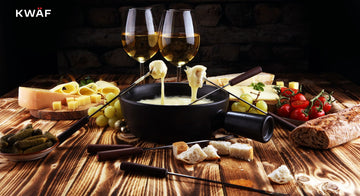Summer is only complete with a cool drink to quench your thirst as the days grow longer and the sun stays out longer. And what better way to celebrate the season than with a homemade blueberry wine? Bursting with this beloved fruit's sweet and tart flavor, blueberry wine recipe is a delightful treat, perfect for sharing with friends and family on a balmy evening.
This guide will take you through crafting your batch of blueberry wine, from selecting the perfect ingredients to bottling your creation. Even if you're a novice winemaker, fear not! This recipe is designed to be approachable and beginner-friendly. So, grab your favorite playlist, gather your supplies, and get ready to embark on a rewarding homemade winemaking adventure!
Let's Get Started: Understanding the Basics
Essential Equipment
Before diving into the ingredients, let's ensure you have the necessary equipment for successful fermentation:
- Primary Fermenter: An ideal primary fermenter is a large food-grade plastic bucket with an airlock. It should be big enough to comfortably hold your chosen volume of fruit and liquid, allowing headroom during fermentation.
- Siphon: This handy tool will help you transfer your wine without disturbing the sediment at the bottom.
- Carboy: This glass jug will be your wine's home during secondary fermentation and aging. Choose one sized appropriately for your recipe's final volume.
- Hydrometer: This instrument measures the sugar content of your must (unfermented grape juice) and wine, helping you determine the alcohol content and monitor fermentation progress.
- Wine Thief: This long, narrow tube allows you to easily extract small wine samples for testing without disturbing the contents of your carboy.
- Bottles and Corks: Invest in good quality, sterilized wine bottles and corks designed for winemaking.

Sanitization is Key!
Cleanliness is crucial throughout the winemaking process to prevent unwanted bacteria or mold growth. Before using, thoroughly sanitize all your equipment with a suitable sanitizing solution.
Blueberry Wine Recipe: A Step-by-Step Process
Now that you're equipped and ready let's gather the ingredients for your homemade blueberry wine:
Ingredients (for a 1-gallon batch):
- 3-4 lbs fresh blueberries (or 5 lbs frozen blueberries)
- 2 lbs granulated sugar
- 1-gallon spring water
- ½ teaspoon pectic enzyme
- ½ teaspoon acid blend
- One teaspoon of yeast nutrient
- ¼ teaspoon wine tannin (optional)
- One packet of wine yeast (labeled explicitly for fruit wines)
- Campden tablets (optional)
Instructions:
- Prepare the Blueberries: Sort and rinse your fresh blueberries, discarding any damaged or moldy ones. If using frozen blueberries, thaw them completely and drain any excess liquid.
- Extract the Flavor: Gently mash the blueberries using a potato masher in a large pot. This helps release their juices and facilitates better flavor extraction during fermentation.
- Sugar Syrup Creation: In a separate saucepan, heat about a quart of water until boiling. Add the sugar and mix constantly until it dissolves; this creates a sugar syrup that can be added to the blueberry mixture later.
- Combining the Ingredients: Pour the mashed blueberries into your sanitized primary fermenter. Add the remaining water (ensure it's cool or lukewarm) and the prepared sugar syrup. Stir well to combine all the ingredients.
- Enhancing the Wine: Now, it's time to add the pectic enzyme, acid blend, and yeast nutrient. These play specific roles in the winemaking process:
- Enzyme for pectin: This breaks down the pectin in the blueberries, helping clarify the wine and improve juice extraction.
- Acid blend: This helps balance the sweetness of the blueberries and contributes to the overall flavor profile of the wine.
- Yeast nutrient: This provides essential nutrients for the yeast, promoting healthy and efficient fermentation.
The addition of wine tannins is optional. Tannin adds a touch of astringency and complexity to the wine, but it's optional for this recipe.
Let it Rest: Cover the primary fermenter with a sanitized lid and let the mixture sit for 24 hours at room temperature. This allows the pectic enzyme to work its magic and the flavors to meld.

Introducing the Yeast: After 24 hours, sprinkle the wine yeast over the surface of the blueberry mixture. Toss it in after you wait. Seal the fermenter tightly by placing the lid on top and sealing it with the airlock, which should be filled with water. Carbon dioxide can escape through the airlock during fermentation, which keeps out other contaminants.
The Fermentation Journey Begins
The Magic of Fermentation: Within a day or two, you should witness bubbling activity in the airlock, indicating active fermentation. This is when the yeast consumes the sugars in the blueberry mixture and converts them into alcohol and carbon dioxide.
Patience is Key: Fermentation can take several weeks, typically 4-6 weeks. During this time, it's essential to be patient and let the process unfold naturally.
Monitoring Progress: Every few days, check the airlock for bubbling activity. You can also take a gravity reading using your hydrometer. The specific gravity will decrease as the yeast consumes sugar, indicating fermentation progress.
Punching Down the Cap: For fermentation's first week or two, it's beneficial to "punch down the cap" daily. The cap refers to the layer of fruit pulp and skins accumulating on the surface. Punching down involves gently stirring or pressing the cap back into the liquid using a sanitized spoon. This helps extract additional flavor and color from the blueberries and prevents mold growth.
Racking and Secondary Fermentation
Transferring to the Carboy: Once fermentation slows down significantly and the gravity reading stabilizes (indicating minimal sugar conversion), it's time to transfer your wine to a Carboy for secondary fermentation. This process removes the wine from the sediment (lees) that settles at the bottom of the primary fermenter.
Siphoning: Using a sanitized siphon, carefully transfer the clear liquid (wine) into the carboy, leaving the sediment behind in the primary fermenter. Discard the sediment or compost it.
Topping Up: After siphoning, you may notice a slight headspace in the carboy. You can "top up" the carboy with sterilized water to minimize air exposure, which can affect the wine's quality.
Airlock Reattached: Attach a sanitized airlock (filled with water) to the carboy. Secondary fermentation is typically less vigorous, with minimal bubbling activity in the airlock.

Secondary Fermentation and Aging: Secondary fermentation can last several weeks to months, depending on your desired sweetness level and flavor profile. Patience is key! During this time, store your carboy in a cool, dark place with minimal temperature fluctuations.
Optional Sweetening: If you prefer a sweeter wine, add some sterilized concentrated grape juice or potassium sorbate and potassium metabisulfite (to prevent further fermentation) at bottling time. However, taste your wine periodically throughout secondary fermentation to determine if additional sweetness is needed.
Bottling and Enjoying Your Creation!
Bottling Day: Once your wine is clear and has reached your desired sweetness level, it's ready for bottling! Ensure all your bottles and corks are thoroughly sanitized.
Siphoning Again: Carefully pour the wine into the bottles, leaving approximately one inch of headspace, using a sterile siphon to transfer it from the carboy.
Corking: Securely insert sterilized corks into the bottles with a wine corker.
Storage: Store your bottled blueberry wine upright in a cool, dark place for several months to allow the flavors to mature and develop further.
Celebrate Your Achievement! After all your hard work and dedication, it's finally time to enjoy your homemade blueberry wine! The vibrant color, delightful aroma, and unique flavor profile will surely be a source of satisfaction.
Experiment and Explore: This blueberry wine recipe is a fantastic starting point for your winemaking adventures. Feel free to experiment with different berry varieties, adjust the sweetness level to your taste, or add a touch of oak chips for added complexity.
Explore Wine Aeration: After uncorking your homemade blueberry wine, consider using a wine aerator to enhance its flavor and aroma. Aeration helps soften tannins and allows the wine's bouquet to develop fully. Explore the wide variety of wine aerators available at kwafwineaerators.com to find the perfect one for you.








